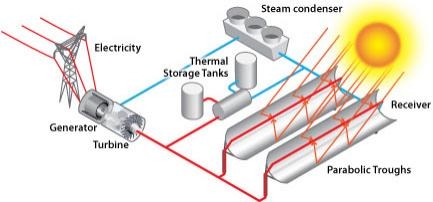 Concentrated solar thermal with storage (aka solar baseload) remains “The technology that will save humanity.” And we are seeing more and more plants in various phases of construction (see “World’s largest solar plant with thermal storage to be built in Arizona — total of 8500 MW of this core climate solution planned for 2014 in U.S. alone“).
Concentrated solar thermal with storage (aka solar baseload) remains “The technology that will save humanity.” And we are seeing more and more plants in various phases of construction (see “World’s largest solar plant with thermal storage to be built in Arizona — total of 8500 MW of this core climate solution planned for 2014 in U.S. alone“).
The easiest way to deal with the intermittency of the sun is cheap storage — and thermal storage is much cheaper and has a much higher round-trip efficiency than electric storage. The ability to provide power reliably throughout the day and evening in key locations around the world (including China and India) is why CSP delivers three of the 12 – 14 wedges needed for “the full global warming solution.”
Now “A Santa Monica, Calif., company called SolarReserve has taken a step toward making that a reality, filing an application with California regulators to build a 150-megawatt solar farm that will store seven hours’ worth of the sun’s energy in the form of molten salt,” as the NYT’s Green Inc. reports today. “Heat from the salt can be released when it’s cloudy or at night to create steam that drives an electricity-generating turbine.” And SolarReserve has a big-time Fortune 50 clean energy partner:
United Technologies has licensed the technology to SolarReserve and will guarantee its performance — a crucial advantage for the startup when it seeks financing from skittish bankers to build the Rice solar farm.
Here are more details:
The Rice Solar Energy Project, to be built in the Sonoran Desert east of Palm Springs, will “generate steady and uninterrupted power during hours of peak electricity demand,” according to SolarReserve’s license application.
So-called dispatchable solar farms would in theory allow utilities to avoid spending billions of dollars building fossil fuel power plants that are fired up only a few times a year when electricity demand spikes, like on a hot day.
SolarReserve is literally run by rocket scientists, many of whom formerly worked at Rocketdyne, a subsidiary of the technology giant United Technologies. Rocketdyne developed the solar salt technology, which was proven viable at the 10-megawatt Solar Two demonstration project near Barstow, Calif., in the 1990s….
As many as 17,500 large mirrors — each one 24 feet by 28 feet — will be attached to 12-foot pedestals. The mirrors, called heliostats, will be arrayed in a circle around a 538-foot concrete tower.
Atop the tower will sit a 100-foot receiver filled with 4.4 million gallons of liquid salt. The heliostats will focus the sun on the receiver, heating the salt to 1,050 degrees F. The liquefied salt flows through a steam-generating system to drive the turbine and is returned to the receiver to be heated again.
SolarReserve isn’t the only developer planning to tap molten salt to store solar energy. Abengoa Solar, for instance, intends to use salt storage at its 280-megawatt Solana solar trough plant outside Phoenix.
That project, however, will heat tubes filled with synthetic oil to create steam and transfer some of the heat to salt-filled storage tanks. By using salt for both steam and storage, SolarReserve can generate higher-temperature steam, which will allow the Rice power plant to operate much more efficiently, according to Kevin Smith, SolarReserve’s chief executive.
“Consequently, our system can capture three times the energy for the same pound of salt,” Mr. Smith wrote in an email message. “Plus they have additional ‘bolt on’ equipment, plus multiple heat transfer steps to go from oil to salt to oil and then to steam for electricity generation.”
SolarReserve’s plant will be built on private land — the site of a former World War II-era Army airfield — near the desert ghost town of Rice. The company will air-cool the power plant, avoiding controversies over water use that have dogged other solar projects …
The company said it is negotiating with California utilities to buy the electricity generated from the Rice project and expects the solar farm to go online in October 2013, barring unforeseen delays.
Related Posts:
- The secret to low-water-use, high-efficiency concentrating solar power
- World’s second* largest solar plant to be built in Florida
- World’s largest solar power plants with thermal storage to be built in Arizona

